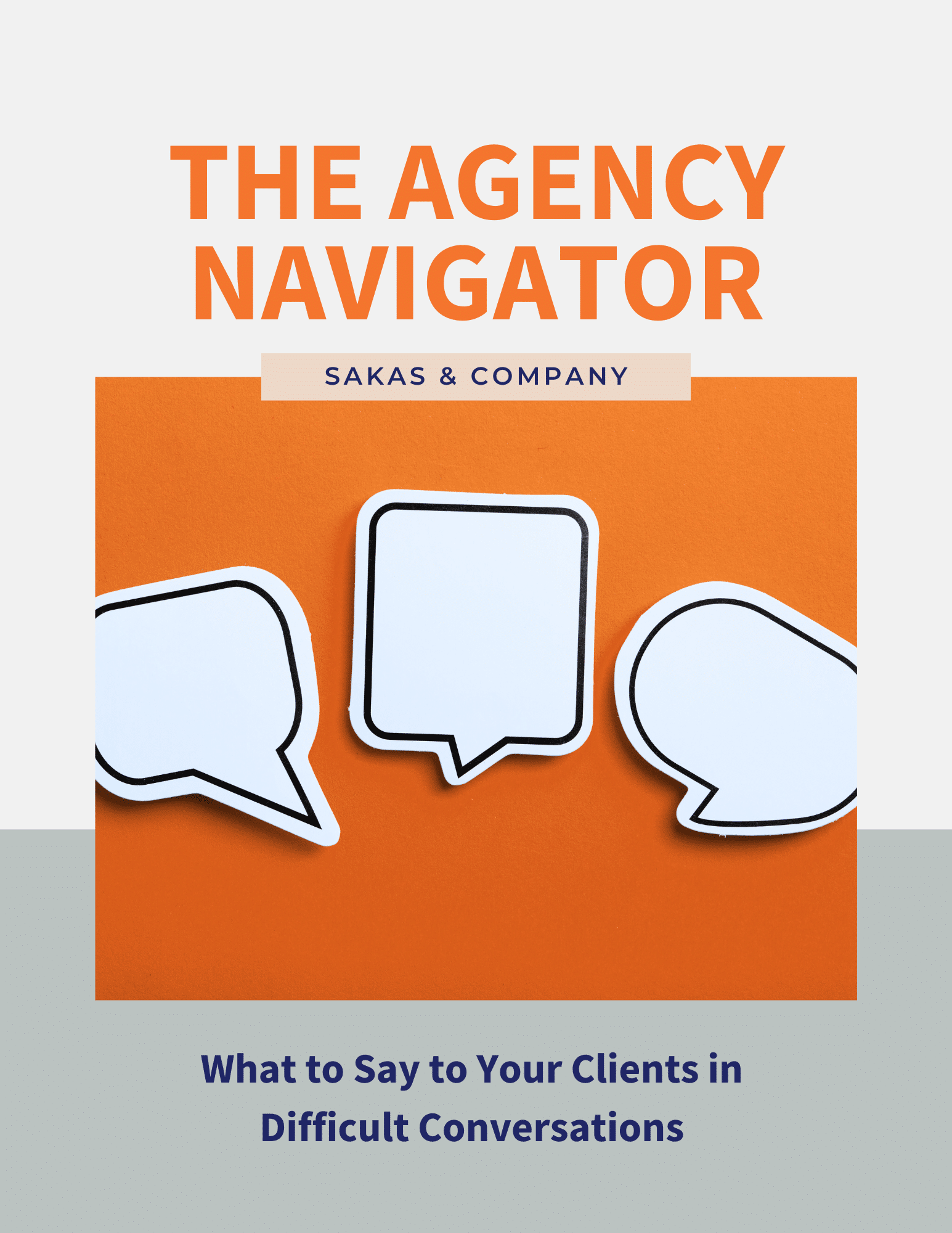When another agency approaches you to do work for one of their clients, it can sound like a great deal. “We get revenues and don’t have to do any sales? Sign us up!” But the reality is more complicated—in my experience, there are many common problems if you don’t think through the arrangement.
It ultimately comes down to whether you’re doing agency whitelabeling (where the hiring agency tells the client your work is its own) or agency partnering (where the underlying client knows that their regular agency isn’t the one doing all the work).
If you’re considering an arrangement where you do client-billable work for another agency, walk through my 10 key points before you sign the contract. You’ll be glad you did!
What is whitelabeling vs. agency partnering?
The name “whitelabel” or “whitelabeling” comes from the fashion industry, where Company A rebrands clothing from Company B to make it look like Company A produced the apparel. This also happens with “store brand” groceries, in credit card processing, with certain SaaS offerings, and other situations.
The alternative to agency whitelabeling is what I call agency partnering—where the underlying client knows that your agency is doing the work, but they’re paying you through their primary agency.
Where can agency whitelabeling go wrong?
For all its potential benefits, whitelabeling can go very badly. The flow of work can fluctuate—sometimes there’s too much and sometimes there’s nothing.
More significantly, you can lose a ton of money on the work you do get, if you aren’t good at managing scope and expectations.
The good news is that you can address or prevent most of the risks—typically by converting it from whitelabeling to agency partnering instead. Let’s look at things to consider when you negotiate.
10 things: Checklist of points to consider (and negotiate) when you’re setting up a whitelabel or agency partnering agreement
In my experience, you want to address these 10 things—some in writing, others in discussion:
- Structure of the Arrangement
- Client Communications
- Scope Management
- Level of Client Expectations
- Performance Measurement
- Profit Potential
- Use of Name in Marketing
- Personality Fit
- Timeline / Urgency
- Negotiating Power
Let’s take a closer look at each one. If you’re currently thinking about signing a contract to do whitelabel work for another agency, please read this before you talk to them again!
1) Structure of the Arrangement
Does the underlying client know you’re doing the work (agency partnership), or is the hiring agency pretending that they’re doing the work you’re doing for their underlying client (whitelabeling)?
Decide which you want—but keep in mind that the closer you are to the person paying the bills, the more power you have. If the client pays the other agency and they pay your agency, it means there’s likely a longer delay between your doing the work and your getting paid for it, potentially an additional 30 days or more.
Will the hiring agency require a non-solicitation clause (that is, you can’t work directly with underlying clients)? This isn’t attractive, but it’s a common clause—especially if you don’t have a strong bargaining position.
Get your lawyer’s feedback. At a minimum, be sure it’s a time-limited non-compete / non-solicitation clause, and try to get a clause that voids the agreement if the client requests you specifically.
2) Client Communications
Can you speak with the clients? Some whitelabel arrangements prohibit the whitelabel agency from speaking with the underlying client—you have to route questions and answers through the hiring agency’s account management team.
If you can’t go directly, this can be an expensive hassle—at a minimum, you should include extra budget for additional revisions and additional PM overhead. Expect content delays, too.
Some hiring agencies let you communicate with the client but require you to use an email address at their agency, to make it look like your people work for the hiring agency. This is common but keep in mind that it means you’ll need to be monitoring yet another email address.
3) Scope Management
If the client wants a broader scope but hasn’t authorized additional budget, who’s in charge of negotiating the out-of-scope? It should be the hiring agency, but they may not always agree whether something is in-scope or not… or which agency is going to eat uncompensated scope changes.
At a minimum, lock in the revisions budget in advance—either a number-of-rounds or a specific dollar amount for revisions. You don’t want to be arguing about that in the heat of battle.
4) Level of Client Expectations
What does the underlying client expect? Are their expectations reasonable or crazy-high? If this were a direct “retail” client, you could do a pre-kickoff survey about expectations.
If the hiring agency isn’t sharing this, you should press for an answer. If they still won’t share, consider whether this project is worth it—you need open communications to succeed at whitelabeling.
As a proxy, think about how important the project would be to the underlying client’s reputation and revenues. If it affects one or both, assume the client’s going to expect a lot. Can you deliver?
5) Performance Measurement
Speaking of delivery, what results or other performance does the underlying client expect? Can you deliver it?
As importantly, can you prove to the client that you actually delivered?
Some hiring agencies negotiate performance-based agreements with whitelabel agencies. Negotiated well, this can be a good way to increase your margins. But identify your backup if the underlying client kills a project partway through—do you get a “kill fee” or other compensation to make up for the performance bonuses lost due to no fault of your own?
6) Profit Potential
Is the other agency charging the client enough so that they can make a profit while paying you what you want?
- If your rate’s $150 and the other agency normally charges $125, it’s not going to work unless they do a special higher rate with the client… or you cut your rate, which I don’t recommend.
- If the other agency is charging $250/hour and paying you $125/hour, you’re in better shape.
It needs to be a win-win; specifics depend on each agency’s business model.
7) Use of Name in Marketing
Can you use the underlying client’s name in your agency’s marketing? Can you use it as a case study, or at least as a portfolio example?
“Use of name” can be very valuable with big brands, since it helps you win other big clients (and easily-impressed smaller clients). Under a whitelabeling agreement, you usually can’t publish that you’ve done work for the underlying client. That doesn’t help your portfolio.
Just as ghostwriters get paid more when they aren’t listed as a co-author, you should demand more money when you can’t take credit for the work. Will the hiring agency agree to this? It all depends on how much they need you vs. you needing them.
Strategically, it may be worth accepting slightly less money if it means being able to add the underlying client’s name to your agency’s client list. I often hear from agency owners who previously did whitelabeling… yet their public portfolio is sparse, because most of their past client work was under NDA.
8) Personality Fit
The extra layer of people (the hiring agency between your agency and the client) creates additional communication overhead—and a higher risk of personality conflicts.
It’s not just you and the client getting along—it’s the client and the other agency, and you and the other agency… and possibly you and the client. Suddenly there are three relationships, not just one.
9) Timeline / Urgency
How fast does the client need (and want) results? If you’re distanced from the underlying client, it means you’re going to be the last to hear things, which makes everything seem like more of a crisis.
As noted before, if the client pulls the plug, what happens to performance fees?
10) Negotiating Power
As I’ve noted above, the person with more power will get the better deal. If you can afford to walk away, you have the power—if the other agency needs you more than you need them, you can demand all sorts of things.
You’ll never probably bring this up directly in negotiations, but it’s the biggest driver of the outcome. Don’t forget it.
How does the other agency benefit by hiring you as a whitelabel agency?
Whitelabeling can be a great way for an agency to provide new services to its existing clients without having to hire new employees.
In my experience, this usually involves an agency hiring an agency that does content marketing, marketing automation, or web design.
Why those three in particular? Because the outside agencies have specialized expertise and an existing team to get things done. The hiring agency doesn’t have to assemble a team of freelancers themselves—for instance, if they need to build a website for an underlying client, the hiring agency could find talent itself… or just hire another agency to do the work.
For instance, one of my clients specializing in marketing automation uses another agency to execute its content marketing services. This lets them avoid hiring copywriters and marketing strategists when that isn’t a core service for them. It lets them get on-demand help, without needing to vet and negotiate with each person doing the work.
Another of my clients specializes in SEO… but then outsources most of its non-technical services.
How does your agency benefit by getting hired as a whitelabel agency?
Taking whitelabel work can be a good way for new agencies to get started—whitelabeling can provide a strong flow of business without the associated sales challenges, especially when a startup agency doesn’t have the reputation to attract enough business directly.
Even for more seasoned agencies, the “revenues without needing to make the sale” concept can be very appealing (although it’s rarely quite that easy). But be careful about getting slotted into the “Do” side of my “Think, Teach, Do” agency services model; your clients will see you as an order-taker, not a strategy-first agency.
What if they’re insisting on whitelabeling and you want agency partnering?
That’s up to you. How much do you want the business if it’s on their terms? Negotiation is less about what you say and more about the strength of your bargaining position.
It’s all about Negotiating Power (item 10 above)—the strongest negotiator is always willing to walk away. Indeed, the person with the stronger bargaining position can “win” by that alone.
If you’re willing to walk away, you’re in a great position. If you need the deal and they’re not budging, you’re going to have to compromise—how much do you want it?
Question: Have you done whitelabeling or agency partnering? What happened?


